Forward-facing child restraint installation using LATCH
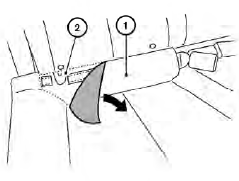
Refer to all Warnings and Cautions in the “Child Safety” and “Child Restraint” sections before installing a child restraint.
Follow these steps to install a forward-facing child restraint using the LATCH system:
1. If the rear seat cushion has a flap 1 , pull the flap down to allow access to the anchors 2 .
2. Position the child restraint on the seat. Always follow the child restraint manufacturer’s instructions.
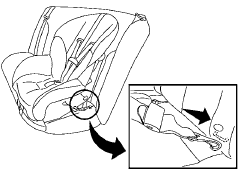
Forward-facing web-mounted – step 3
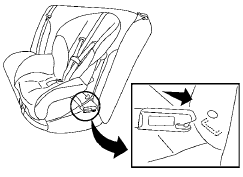
Forward-facing rigid-mounted – step 3
3. Secure the child restraint anchor attachments to the LATCH lower anchors. Check to make sure the LATCH attachment is properly attached to the lower anchors.
If the child restraint is equipped with a top tether strap, route the top tether strap and secure the tether strap to the tether anchor point. See “Installing top tether strap” in this section. Do not install child restraints that require the use of a top tether strap in seating positions that do not have a top tether anchor.
4. The back of the child restraint should be secured against the vehicle seatback. If the seating position does not have an adjustable head restraint and it is interfering with the proper child restraint fit, try another seating position or a different child restraint.
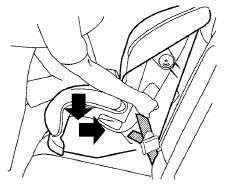
Forward-facing – step 5
5. For child restraints that are equipped with webbing-mounted attachments, remove any additional slack from the anchor attachments. Press downward and rearward firmly in the center of the child restraint with your knee to compress the vehicle seat cushion and seatback while tightening the webbing of the anchor attachments.
6. Tighten the tether strap according to the manufacturer’s instructions to remove any slack.
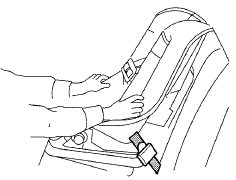
Forward-facing – step 7
7. After attaching the child restraint, test it before you place the child in it. Push it from side to side while holding the child restraint near the LATCH attachment path. The child restraint should not move more than 1 inch (25 mm), from side to side. Try to tug it forward and check to see if the LATCH attachment holds the restraint in place. If the restraint is not secure, tighten the LATCH attachment as necessary, or put the restraint in another seat and test it again. You may need to try a different child restraint. Not all child restraints fit in all types of vehicles.
8. Check to make sure the child restraint is properly secured prior to each use. If the child restraint is loose, repeat steps 2 through 7.
See also:
Exterior and interior lights
* Always check with the Parts Department at a NISSAN dealer for the latest
parts information.
1. Front map lights (if so equipped)
2. Interior light
3. Headlight assembly
4. Front fog lig ...
Fuses
Two types of fuses are used. Type A is used in
the fuse boxes in the engine compartment. Type
B is used in the passenger compartment fuse
box.
Type A fuses are provided as spare fuses. They
are ...
Air bags, seat belts and child restraints
1. Top tether strap anchor (P. 1-26)
2. Rear seat belts (P. 1-13)
3. Roof-mounted curtain side-impact
supplemental air bag (P. 1-41)
4. Front seat-mounted side-impact
supplemental air bag (P. 1 ...
